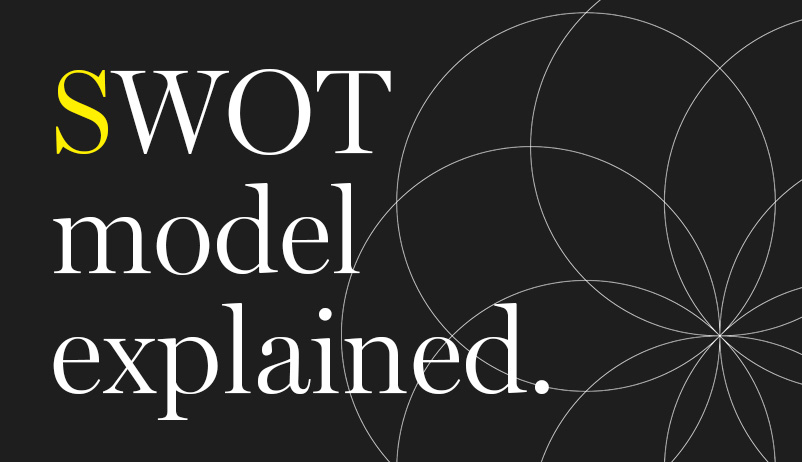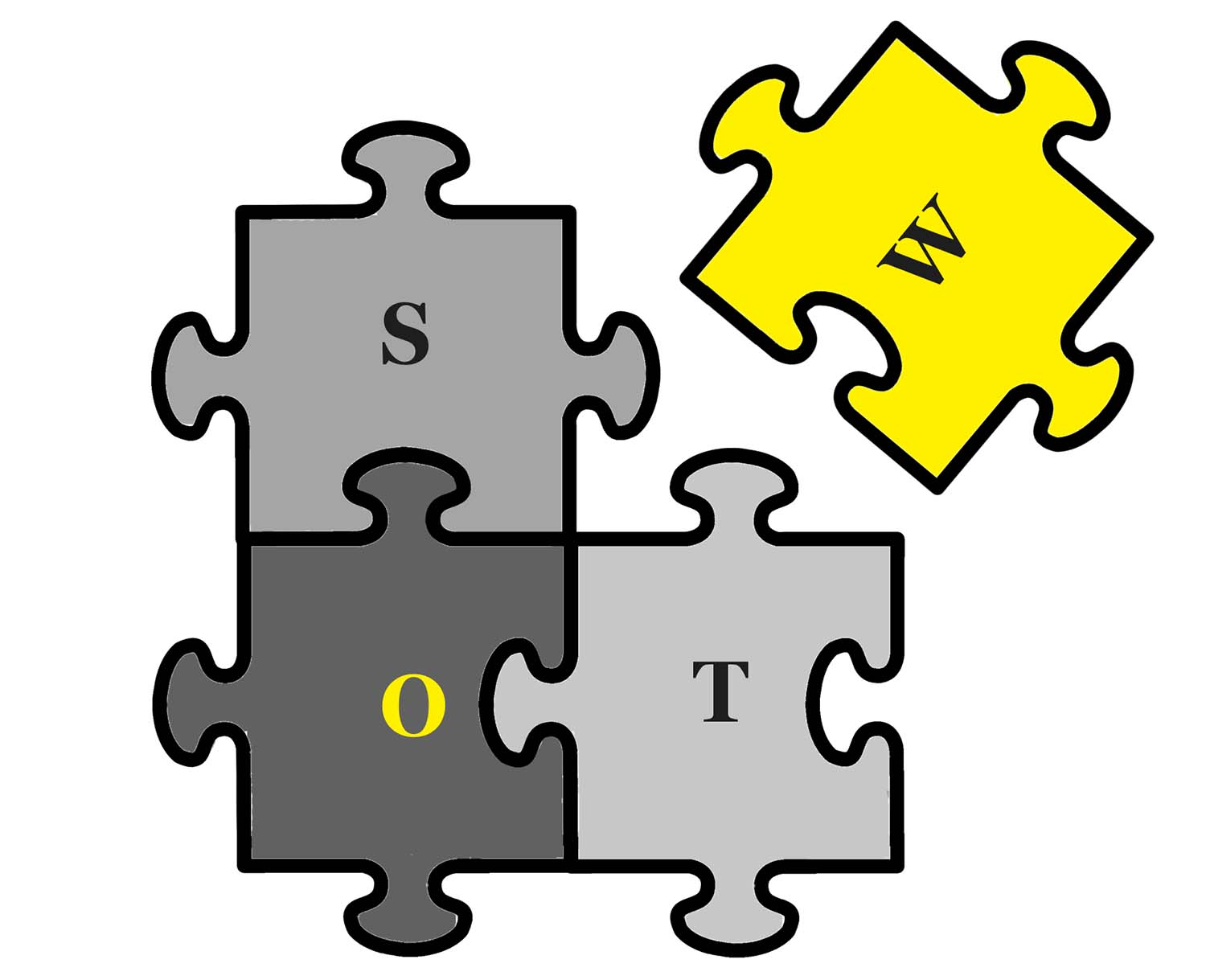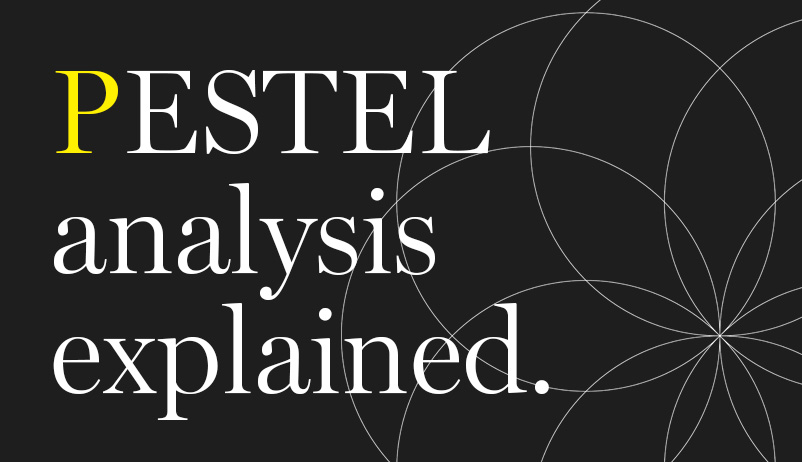
Lorem ipsum dolor sit amet, consectetur adipiscing elit. Suspendisse varius enim in eros elementum tristique. Duis cursus, mi quis viverra ornare, eros dolor interdum nulla, ut commodo diam libero vitae erat. Aenean faucibus nibh et justo cursus id rutrum lorem imperdiet. Nunc ut sem vitae risus tristique posuere.
SWOT Analysis - Its Meaning in Marketing.
In the context of marketing, a SWOT analysis refers to a tool used to evaluate the internal and external factors that can impact a company's competitive advantage. It is used in strategic management to help marketers gain insights into the organisation's current situation and make informed decisions about marketing objectives, target audiences, positioning, and tactics.
What Are the Four Components of SWOT?
Here's how each component of a business SWOT analysis applies to marketing:
- Strengths: These are the internal factors that give a company an advantage over its competitors in the market. Marketing strengths could include a strong brand reputation, unique product features, efficient distribution channels, effective marketing campaigns, loyal customer base, or talented marketing team.
- Weaknesses: These are internal factors that put a company at a disadvantage compared to its competitors. Marketing weaknesses may include poor brand recognition, limited product range, inadequate marketing budget, outdated technology, ineffective communication strategies, or a lack of market research.
- Opportunities: These are external factors in the market that can be advantageous for a company's marketing efforts. Opportunities could arise from emerging trends, new market segments, technological advancements, changes in consumer behaviour, untapped markets, or partnerships and collaborations.
- Threats: These are external factors that can potentially harm a company's marketing performance or pose challenges to its success. Threats may include intense competition, economic downturns, changing consumer preferences, regulatory changes, negative public perception, or disruptive technologies.
By conducting a SWOT analysis, marketers can identify their strengths and leverage them, address weaknesses, capitalise on opportunities, and mitigate potential threats. This analysis helps in formulating effective marketing strategies and making informed decisions to achieve the business plan.

Why Is a SWOT Important?
A SWOT analysis is important for several reasons:
- Strategic Planning: SWOT analysis is a critical component of the strategic planning process. It helps organisations understand their internal capabilities, external environment, and competitive landscape. This understanding enables them to develop effective strategies and make informed decisions to achieve their goals.
- Identifying Competitive Advantage: SWOT analysis helps identify an organisation's unique strengths and competitive advantages. By understanding what sets them apart from competitors, organisations can leverage these strengths to differentiate themselves in the market and gain a competitive edge.
- Risk Assessment and Mitigation: SWOT analysis helps organisations identify and assess potential risks and threats. By recognising these factors, organisations can develop strategies to mitigate risks, address weaknesses, and counter potential threats, thereby minimising the impact on their performance and success.
- Capitalising on Opportunities: SWOT analysis highlights external opportunities that organisations can exploit. By identifying and understanding these opportunities, organisations can align their strengths and resources to capitalise on them, potentially leading to growth, increased market share, or new revenue streams.
- Communication and Alignment: SWOT analysis facilitates communication and alignment within an organisation. It brings together stakeholders from different departments and levels to share insights and perspectives. This collaborative process fosters a shared understanding of the organisation's strengths, weaknesses, opportunities, and threats, promoting a sense of ownership and alignment towards common goals.
Overall, SWOT analysis plays a crucial role in business strategy decision-making, risk assessment, and capitalising on opportunities. It helps organisations gain a comprehensive understanding of their current situation, identify areas for improvement, and develop strategies to achieve sustainable growth and competitive advantage.
What’s the Difference Between SWOT and TOWS Analysis?
A SWOT analysis and a TOWS analysis are similar frameworks used for strategic planning and analysis, but they approach the process from different perspectives. Here's the difference between the two:
SWOT Analysis:
The SWOT analysis focuses on identifying and assessing the internal strengths and weaknesses of an organisation, as well as the external opportunities and threats it faces. It is a tool used to analyse the current situation and understand the factors that can impact the organisation's performance. SWOT analysis helps in identifying areas of competitive advantage or disadvantage and serves as a starting point for strategy development.
TOWS Analysis:
TOWS analysis, on the other hand, is an extension of SWOT analysis. TOWS stands for Threats, Opportunities, Weaknesses, and Strengths. In TOWS analysis, the order of the components is rearranged to emphasise a proactive approach. It encourages strategists to think about how they can leverage their strengths and address weaknesses to take advantage of opportunities and counter threats effectively. TOWS analysis involves combining the internal and external factors to formulate strategies that align strengths with opportunities, minimise weaknesses in the face of threats, and overall maximise the organisation's potential.
In summary, while SWOT analysis is primarily focused on identifying internal and external factors, TOWS analysis builds upon SWOT by providing a framework for developing specific strategies based on the relationships between these factors. TOWS analysis takes a more proactive and strategic approach to leveraging strengths, addressing weaknesses, capitalising on opportunities, and mitigating threats.

SWOT Analysis Example in Retail.
Here's an example of a SWOT analysis in use for a fictional retail clothing store:
Strengths:
- Strong brand reputation and recognition in the local market.
- Wide variety of fashionable clothing options.
- Well-trained and knowledgeable sales staff.
- Effective customer loyalty program in place.
- Prime location with high foot traffic.
Weaknesses:
- Limited online presence and e-commerce capabilities.
- Relatively high prices compared to competitors.
- Inconsistent inventory management leading to stockouts.
- Limited marketing budget for promotional activities.
- Lack of differentiation from competitors in terms of store ambiance.
Opportunities:
- Growing demand for sustainable and ethically sourced clothing.
- Increasing popularity of online shopping in the target market.
- Collaboration opportunities with local fashion influencers and bloggers.
- Expansion into adjacent markets and product categories.
- Introduction of a mobile app for convenient shopping.
Threats:
- Intense competition from established clothing retailers.
- Economic downturn impacting consumer spending.
- Changing fashion trends and customer preferences.
- Rising rental costs in the area.
- Online-only retailers offering competitive pricing and convenience.
By analysing the factors in this example, the retail clothing store can develop strategies to capitalise on its strengths, address weaknesses, take advantage of opportunities, and mitigate potential threats.
For instance, they could invest in building an online store to tap into the growing online shopping trend and improve inventory management to minimise stockouts. They could also explore collaborations with fashion influencers to increase brand visibility and work on differentiating their store ambiance to stand out from competitors.
SWOT Analysis Questions.
When conducting a formal SWOT analysis, you ask a series of questions for each element of the framework. Here are some common questions to consider, but asking more questions will give a more comprehensive analysis:
Strategic Questions to Explore Strengths:
- What are our key drivers of competitive advantage?
- What unique resources or capabilities do we possess?
- What positive attributes do customers associate with our brand?
- What do we do better than our competitors?
- What are our strongest market segments or customer relationships?
Strategic Questions to Explore Weaknesses:
- What areas do we need to improve or address?
- What internal limitations or challenges do we face?
- Where do we lag behind our competitors?
- What negative feedback or complaints do we receive from customers?
- Are there any skill gaps or resource constraints within our organisation?
Strategic Questions to Explore Opportunities:
- What emerging trends or market changes could benefit our organisation?
- Are there any untapped market segments or customer needs?
- Can we leverage new technologies or innovations to our advantage?
- Are there potential partnerships or collaborations that could create opportunities?
- Are there any regulatory changes or industry developments that we can capitalise on?
Strategic Questions to Explore Threats:
- Who are our main competitors, and what are their strengths?
- Are there any shifts in consumer behavior or preferences that could impact us?
- What economic, political, or social factors pose risks to our organisation?
- Are there any disruptive technologies or market trends that threaten our business model?
- Are there any potential legal or regulatory threats we need to be aware of?
- Are there any other external threats we may have overlooked?
These questions serve as a starting point for conducting a comprehensive SWOT analysis and can be customised based on the specific industry, organisation, or objectives. They help in identifying key factors, gathering relevant information, and generating insights for strategic decision-making.

"SWOT analysis is a crucial marketing tool, yet very few businesses use it, or apply it in the right way. When used properly alongside other frameworks, it aids in strategic planning, identifies business advantages, and mitigates risks for effective decision-making and achieving business objectives."
Paul Mills
Founder, VCMO
What Are the Advantages of SWOT?
A SWOT analysis offers business leaders several advantages that make it a valuable tool for strategic planning and decision-making. Here are five key advantages of using SWOT analysis:
- Simple and Easy to Use: SWOT analysis is a straightforward and user-friendly tool that can be easily understood and applied by individuals at various levels within an organisation. It doesn't require specialised knowledge or training, making it accessible to a wide range of users.
- Comprehensive Assessment: SWOT analysis provides a comprehensive assessment of both internal and external factors affecting an organisation. By evaluating strengths, weaknesses, opportunities, and threats, it helps identify critical factors that impact performance and competitiveness.
- Identifies Strategic Insights: SWOT analysis enables organisations to gain valuable insights into their current situation and strategic position. It helps in understanding core competencies, areas for improvement, market opportunities, and potential risks. This knowledge can guide decision-making and strategy formulation.
- Supports Strategy Development: SWOT analysis serves as a foundation for strategy development. It helps organisations align their strengths with opportunities and develop strategies to address weaknesses and mitigate threats. It provides a structured approach for creating action plans and making informed strategic choices.
- Flexibility and Adaptability: SWOT analysis is a flexible tool that can be customised to the specific needs and context of an organisation. It can be applied to various levels of analysis, from the overall organisation to specific projects or initiatives. SWOT analysis can also be conducted periodically to track changes in the internal and external environment and adjust strategies accordingly.
Overall, a SWOT analysis provides a structured framework for assessing an organisation's current state, identifying strategic insights, and guiding decision-making. By leveraging its advantages, organisations can better understand their competitive position, identify growth opportunities, and develop effective strategies to achieve their goals.
What Are the Disadvantages of SWOT?
While SWOT analysis has numerous benefits, it's important to be aware of its potential limitations and disadvantages. Here are six key disadvantages associated with using SWOT analysis:
- Subjectivity and Bias: SWOT analysis heavily relies on subjective judgments and opinions, which can introduce biases into the process. Different individuals or teams may have varying perspectives on the same factors, leading to inconsistent or skewed assessments. This subjectivity can undermine the reliability and objectivity of the analysis.
- Lack of Prioritisation: SWOT analysis provides a comprehensive overview of an organisation's strengths, weaknesses, opportunities, and threats, but it doesn't inherently prioritise or rank them. Without a clear prioritisation framework, it can be challenging to determine which factors are most significant or require immediate attention. This can make it difficult to focus on the most critical issues.
- Limited Actionability: While SWOT analysis helps identify internal and external factors, it doesn't provide specific guidance on how to address or capitalise on them. It doesn't offer detailed action plans or implementation strategies. Organisations may need to supplement SWOT analysis with additional tools or frameworks to translate the analysis into actionable steps.
- Lack of Depth and Context: SWOT analysis provides a broad overview of the organisation's situation but may not delve deeply into specific factors or their underlying causes. It may overlook nuanced details or fail to consider the broader industry or market context. This lack of depth and context can limit the analysis's effectiveness in capturing the complexities of the business environment.
- Static and Snapshot Analysis: SWOT analysis is often conducted at a specific point in time, providing a snapshot of the organisation's situation. However, the business environment is dynamic and constantly evolving. Factors identified in the analysis may change rapidly, making the analysis outdated or irrelevant. Regular updates and monitoring are necessary to maintain its relevance.
- Overemphasis on Internal Factors: SWOT analysis tends to focus more on internal factors (strengths and weaknesses) rather than external factors (opportunities and threats). This internal focus may result in overlooking or underestimating critical external factors that can significantly impact the organisation's performance.
To overcome these disadvantages, organisations can complement SWOT analysis with other strategic planning tools, conduct thorough research, involve diverse perspectives, and regularly revisit and update the analysis to reflect changing circumstances. This holistic approach can enhance the effectiveness and reliability of the strategic analysis process.

What Other Frameworks Can Be Used With SWOT?
There are several frameworks and tools that can be used in conjunction with SWOT analysis to enhance strategic planning and decision-making. Here are some commonly used frameworks:
PESTEL Analysis
PESTEL (Political, Economic, Social, Technological, Environmental, and Legal) analysis helps assess the external macro-environmental factors that can impact an organisation. It provides a broader understanding of the political, economic, social, technological, environmental, and legal influences on the business, complementing the external factors identified in SWOT analysis.
Porter's Five Forces Model
Porter's Five Forces analysis examines the competitive forces within an industry to assess its attractiveness and potential profitability. It analyses the bargaining power of suppliers, buyers, competitive rivalry, threat of new entrants, and threat of substitutes. Combining SWOT analysis with Porter's Five Forces helps organisations gain a comprehensive understanding of their competitive landscape.
Value Chain Analysis
Value Chain analysis breaks down the organisation's activities into primary and support activities to identify areas of competitive advantage and cost optimisation. By examining each activity's value-adding potential, organisations can align their strengths and weaknesses with specific activities and identify opportunities for improvement.
Ansoff Matrix
The Ansoff Matrix helps organisations explore growth strategies by considering market penetration, market development, product development, and diversification. It complements the opportunities identified in SWOT analysis and helps organisations evaluate various growth options and their associated risks.
Balanced Scorecard
The Balanced Scorecard is a performance measurement framework that focuses on multiple dimensions beyond financial metrics. It considers perspectives such as customer, internal processes, learning and growth, and financials. By aligning SWOT analysis findings with the Balanced Scorecard, organisations can develop a more balanced and comprehensive strategy.
Gap Analysis
Gap analysis compares an organisation's current state (as identified through SWOT analysis) with its desired future state or goals. It helps identify the gaps or areas of improvement that need to be addressed to achieve the desired objectives. By combining SWOT analysis with gap analysis, organisations can develop actionable strategies to bridge the identified gaps.
These frameworks provide additional perspectives, depth, and structure to the strategic planning process when used in conjunction with SWOT analysis. They can help organisations gain a more holistic view of their internal and external environment and guide the development of effective strategies. The selection of a specific framework or combination depends on the organisation's needs, industry, and strategic objectives.
Recap on SWOT.
In conclusion, a SWOT analysis is a valuable strategic planning tool that offers several advantages. It provides a simple and comprehensive assessment of an organisation's internal strengths, weaknesses, as well as external opportunities and threats. SWOT analysis helps identify strategic insights, supports strategy development, and fosters communication and collaboration within the organisation.
However, it also has limitations. SWOT analysis can be subjective and prone to bias, lacks prioritisation, and may not provide specific action plans. It may also overlook external factors and fail to capture the dynamic nature of the business environment.
By being aware of these limitations and complementing SWOT analysis with other frameworks, organisations can maximise its benefits and make more informed decisions in their strategic planning processes.
About VCMO
VCMO is a UK-based provider of fractional marketing services, supporting B2B SMEs—ranging from funded scale-ups to mid-tier and private equity-backed businesses—through key moments of growth and transformation. Its Chartered Fractional CMOs and SOSTAC® certified planners embed strategic marketing leadership into organisations navigating product launches, new market entry, acquisitions, and leadership gaps.
Ready to take your marketing to the next level? Let us help you get there.
Subscribe to Our Newsletter
Fractional Edge is our montly newsletter sharing expert opinion on the latest trends in fractional leadership, curated marketing content from leading sources, VCMO events, and much more. Subscribing is quick — just add your name and email.










